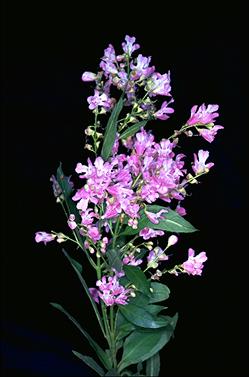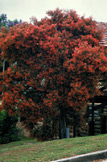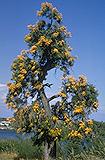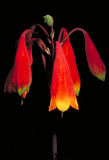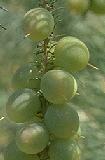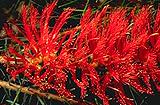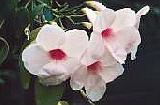The New South Wales Christmas Bush, Ceratopetalum gummiferum, is another small tree. It can vary from 3-10m high x 2-6m. The plants at Karwarra prefer to take on a more conical shape and may reach 6m or more. The common name stems from the fact that, in NSW, the shrub is entirely covered in orange to red flowers on Christmas Day - an amazing sight. Not wishing to be as flamboyant down here in Victoria we have our NSW Christmas bushes more subtly dressed in white and shades of pale orange. Because Karwarra Garden is higher up, this shrub is still completely white for Christmas Day. By March/April our shrubs have taken on the brilliant burnt orange, better timed to brighten our autumn gardens!
Several forms of this species are now available, ranging from so-called dwarf forms to forms with different flower or leaf colour. My favorite is 'Magenta Star' a smaller plant with deep magenta new foliage. All have masses of small flowers, the calyx lobes (sepals) being the floriferous part of the plant as the white petals soon fall off. The sepals become enlarged as they age. Flowers gradually change from white through to deep red over several months, appearing multi-coloured. Leaves are trifoliolate (leaflets in threes), dark green on top with fine teeth along the margins. New growth is orange-red. NSW Christmas bush is a reliable garden specimen growing in most conditions but requiring extra water during dry periods. It is also a plant of the forests and will grow in shade or partial sun. Our large plants receive full sun for most of the day but never feel the hot west sun. Flowering is not as good in the shade, consequently the most spectacular flowers are often viewed from the roof of Karwarra Hall. The Western Australian Christmas Bush, Nuytsia floribunda, is truly spectacular with its masses of orange sprays from October to January. This tree is parasitic and some success has been achieved growing it with other species such as Acacia myrtifolia. I have not attempted to grow this species at Karwarra Garden.
A tufty group of plants, collectively known as Christmas Bells occur in Queensland, New South Wales and Tasmania. Blandfordias are lilies with typical grass-like leaves and tall flowering stems showing off the large red and/or yellow bell-shaped flowers. We have grown Blandfordia punicea in our Tasmanian garden from time to time but flowering has always been its demise unfortunately. The tall B.grandiflora performs much better providing a beautiful display near our ponds each year in summer. Plants require a moist situation. While the above species are called 'Christmas Trees', there are many other plants which can be used as a replacement for the exotic pine tree. My favourite Aussie equivalent is Persoonia pinifolia. What an excuse to plant another one! This shrub of 3-4m high has gracefully drooping pine-like foliage. Its yellow flowers, hanging in a spike at the ends of the branches. begin to open in mid summer and continue for the next 6-8 months. As the flower finishes a small drupe appears. By spring these appear as bunches of large green 'grapes', becoming red-purple before falling. We have several shrubs growing at Karwarra, tolerating a range of conditions from heavy shade to partial sun.
My Christmas Tree at home is Calothamnus quadrifidus. It is planted in a half keg outside the lounge window where its brilliant red bottlebrush flowers give the most wonderful display through December/January. The foliage is a soft fine and grey. The flower occurs on only half of the stem but this doesn't bother the honeyeaters who appear to share our house as they feed from the nectar and squabble about who got there first, or who is the biggest. They will also nest in it, providing us with the delights of the babies each year. This plant was tending to look a little scruffy because of a dense Pandorea jasminoides overhanging it but a very hard prune of both has seen new shoots appearing around the lower stems. The Pandorea is of course a 'Christmas creeper'.
Calothamnus prefer a hot dry site and most do not grow well at Karwarra Garden. There are several species and most will provide an attractive shrub with a bountiful supply of red flowers over the festive season. Other plants for your Christmas garden are kangaroo paws. Australian pines including Callitris oblonga. an upright blue-foliaged species and the King Billy Pine (Athrotaxis selaginiodes). Allocasuarinas, fine leafed banksias such as Banksia ericifolia and the beautiful weeping Leptospermum brevipes or 'Slender Tea-tree'. I'm sure you can add more to the list. Why not look at your garden over December and supply a list of your favourite 'Christmas plants' to the editor to publish next year. From "Growing Australian", newsletter of the Australian Plants Society (Victoria), December 1999.  [Front Page] [Features] [Departments] [Society Home] [Subscribe] Australian Plants online - December 2000 |

